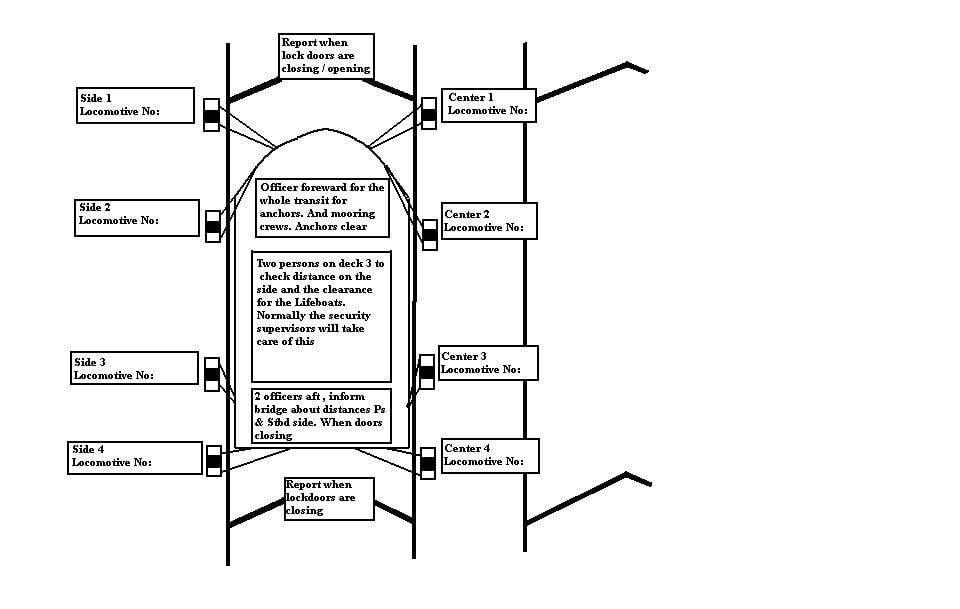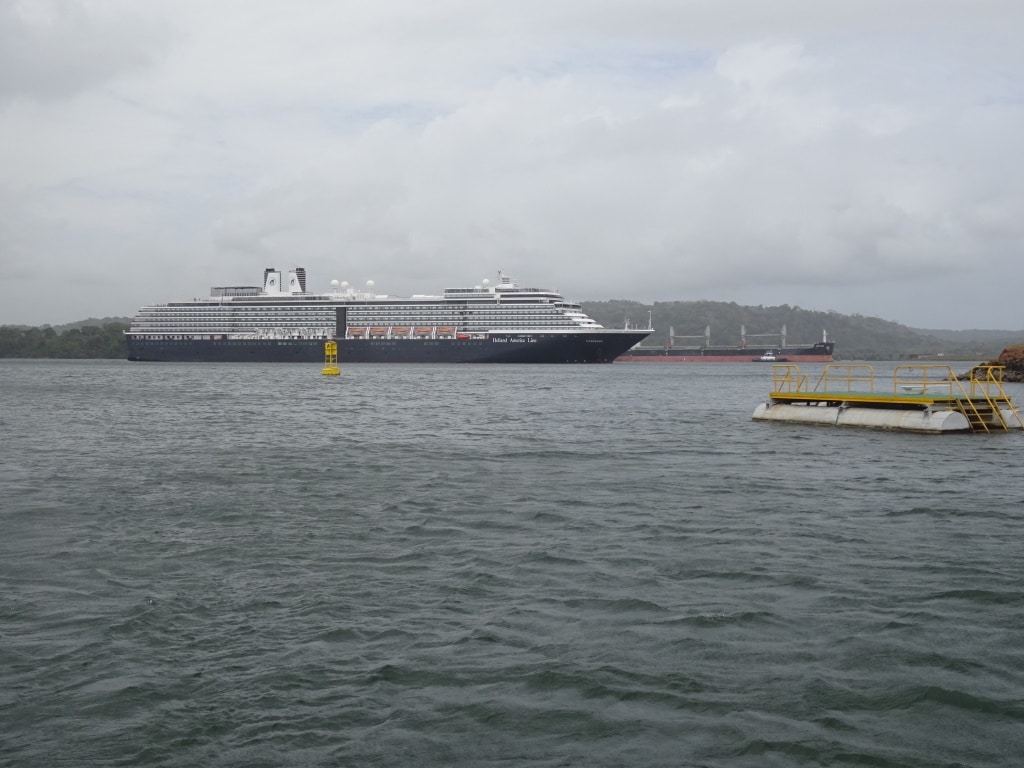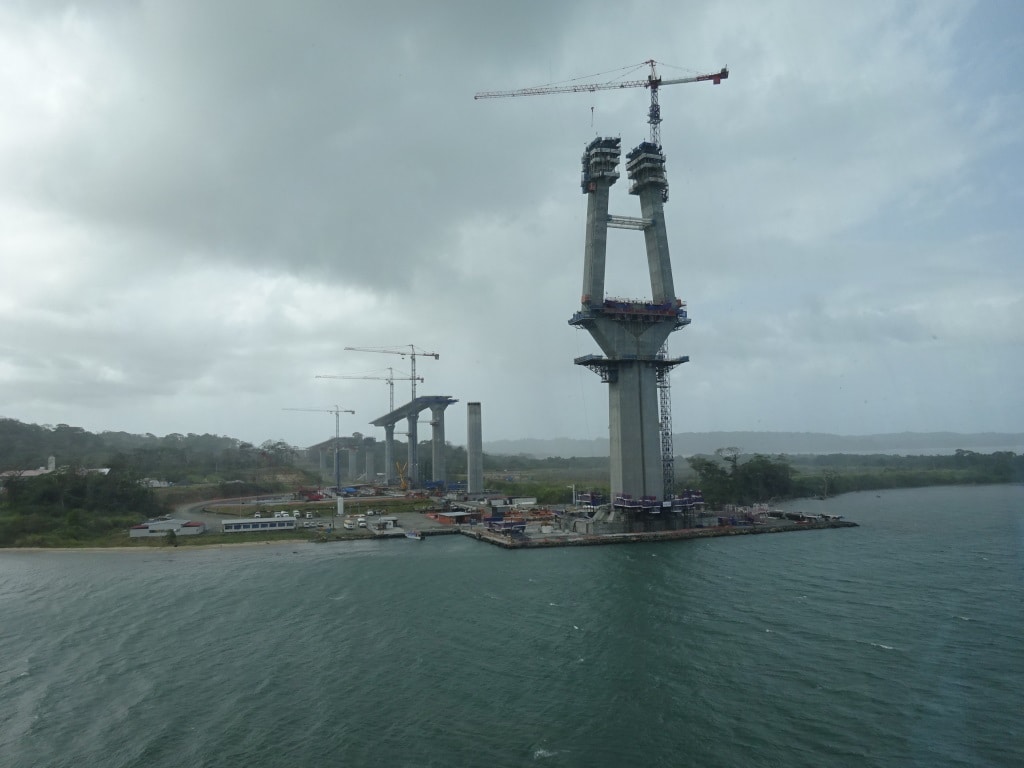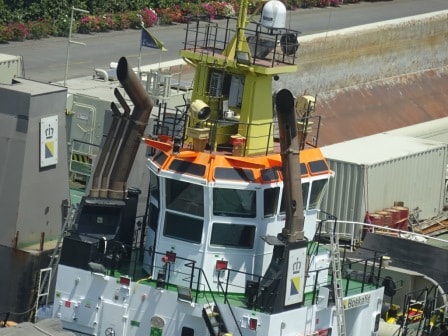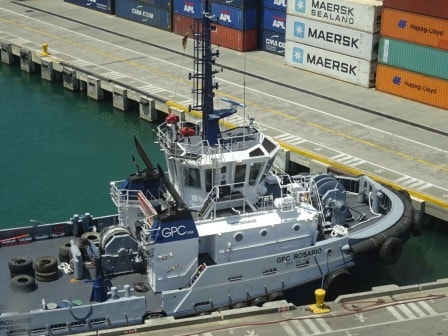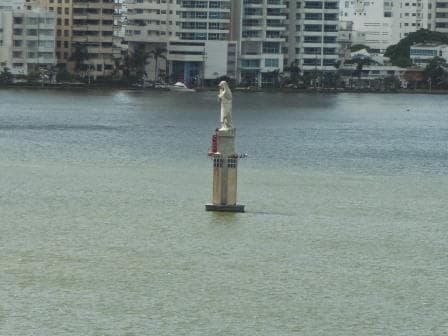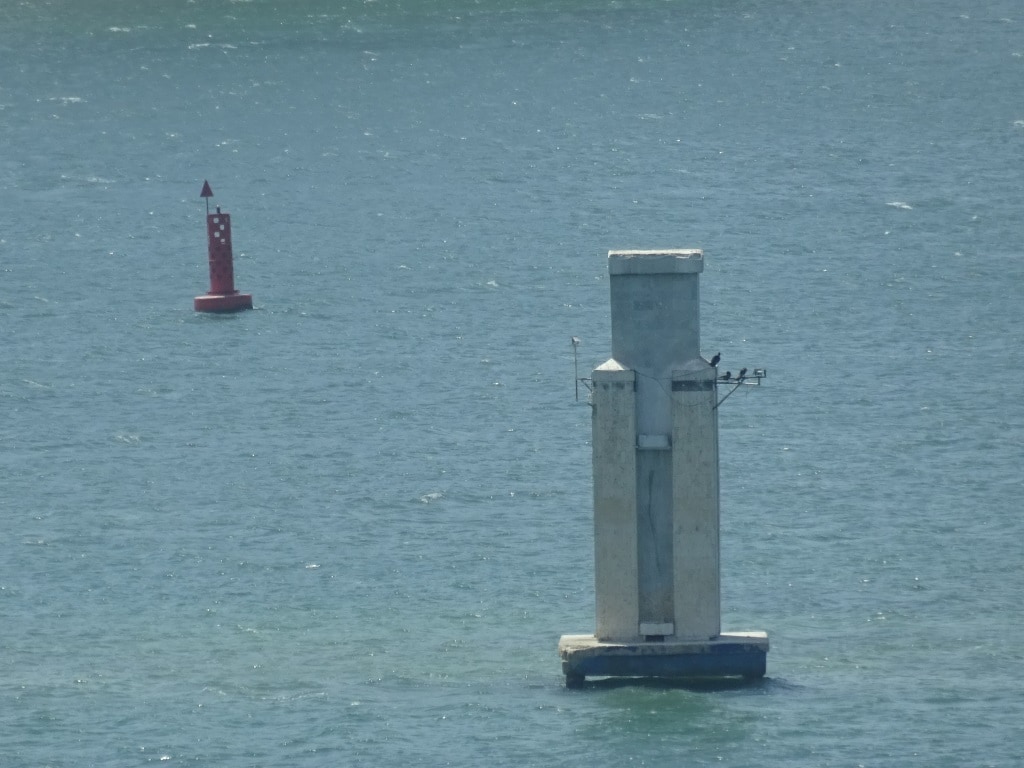When there is bad weather in the offing, then as a captain you always have to decide: how much are you going to tell the guests, how much detailed information to be given, what is enough to prepare them without confusing the message. Once you have done that, the waiting game starts until the bad weather comes through and you can find out how good your predictions were and if real life –ship in storm- equates to the guests perspective. The understanding achieved by the warnings given. There is no captain in the world who minds to be called a liar if the weather is less bad than he/she predicted but at the same time there is the nagging feeling of will they believe me next time or will they just think that I am always exaggerating. Continue reading
Category: Panama Canal (page 3 of 3)
The weather gods were with us and we arrived to observe a nice dry Panama day. The schedule worked out this time and the ms Zuiderdam moved into the first lock chamber at 06.30, just when the sun was rising. And that made it not too hot for standing outside on deck and watching the proceedings. By 08.00 we were out and moved to the anchorage to land over a 1000 guests on the land tour. We accomplished that by 11.00 hrs. and then we had to wait to go back into the schedule again.
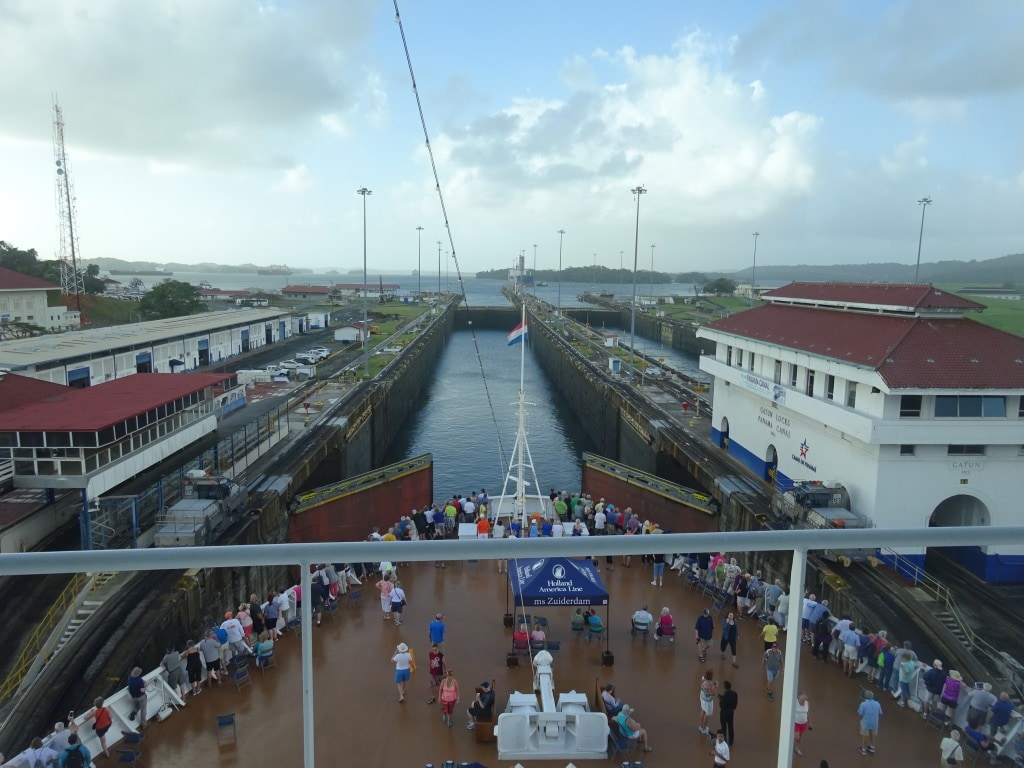
Sometimes guests ask me how often I have been in the Panama Canal, with these sort of dive in – dive out cruises you quickly build up a good number and I have now passed the 100 times in the Canal, although not 100 crossings yet.
From then on it was less smooth. Some big boys, panamax ships had to come through and they go slow as there is hardly any water flow around these ships as they are so tight to the lock walls at both sides. I think the original designers back in 1900 had never envisioned that some ships would be going through that would only fit exactly in the locks with only enough spare space so that the water could flow around the ship. We have now progressed to the 2nd Panama Locks where post-panamax ships can go through and we saw a few of them waiting today. They are either too long for the old locks or too wide or both.
Still it delayed us and the wish of the Captain for the ship to be docked in Colon by 16.00 hrs. was not going to be fulfilled and we were docked there just after 17.00 hrs. Hopefully the guests who were on the dock by 16.00 hrs. took his advice and parked themselves in the Bar with a cool drink in their hands. It is a very satisfying way to wait and see your “apartment” arriving and being parked in front of you.
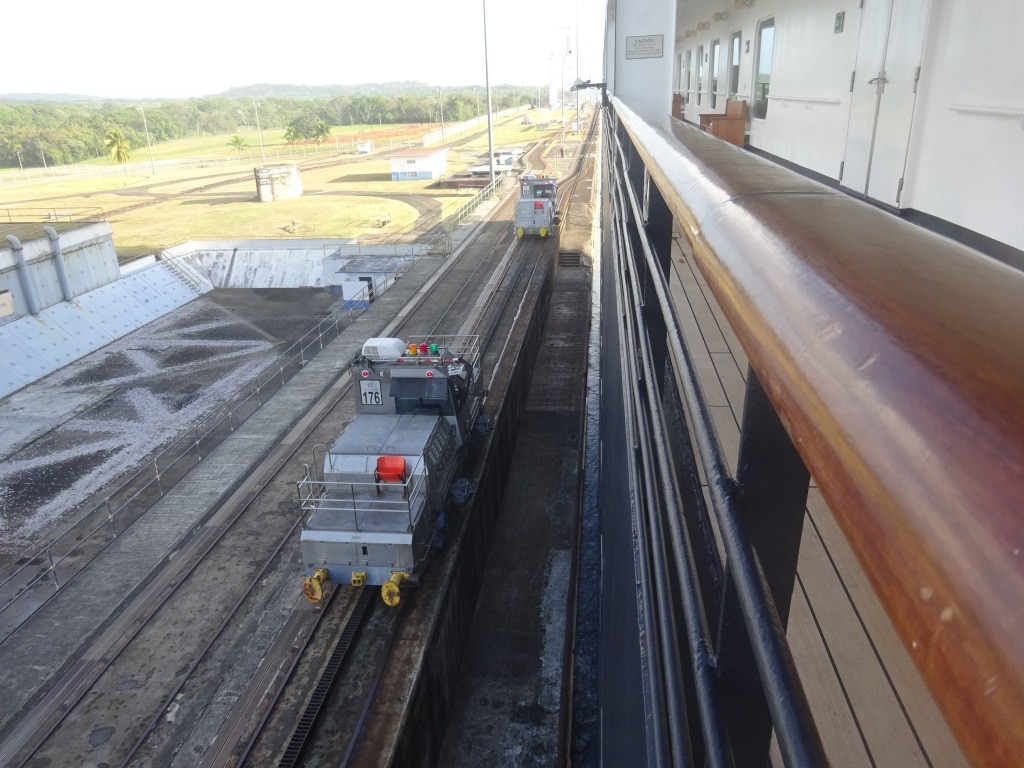
With high ships like the Zuiderdam we sometimes have 4 mules aft. Then the very last ones make fast on the mooring deck and the two more forward give out a wire to the Lower promenade deck where we have special Panama Canal bollards installed on the walk around deck. We have then 2 officers aft, one on the mooring deck and one on the higher deck 3.
For the officers on the bridge and fore and aft, the main duty during a Panama Canal operation is to monitor and keep track of what the Canal people are doing. The pilots bring their own sailor crew and their own tugboats, and while going in and out of the locks they have the locomotives or mules control the ship.
Maintaining the ships log on the bridge is the core duty. Since the grey mists of time, ships have maintained ships logs which note the most important things that happen to ensure there are records for just in case………………… In the old days, until about 10 years ago, it was with paper and pen, and then the electronic logs came. For each situation a template was developed and the Assistant officer of the watch fills in the blanks. For the odd situation that there is no template, there is a Free text option to cover the situation.
The officers fore and aft pass on the information about the entering and leaving the locks and when the locomotives have been made fast or have been released by the Panama Canal Crew. The handling of the wires from the locomotives are about the most dangerous part of the whole evolution so the officers on the mooring decks are watching like hawks to ensure that the work is done safely and with regard for the ships property. Occasionally a tugboat needs to be made fast and that is normally done by the ship’s crew as it mostly occurs when the Panama Canal pilot is not yet on board. Like when we have to wait as the entering of the locks has been delayed.
Tonight at 20.00 we will sail again and head for Puerto Limon in Costa Rico. That will be full speed and even with an hour back it is a very tight schedule. Weather for tomorrow, light winds and temperature of 27oC or 80 oF, with a 50% chance of a shower in the early afternoon.
Today went sort of on schedule although we were not able to repeat the performance from last cruise when were docked by 15.00 hrs. in Colon. Now it was just before 17.00 hrs. and nothing we could do about it. It all depends on when we fit into the slot for the traffic going through the Gatun Locks. That is the traffic coming from the Pacific side. This time there was no early gap and thus the ms Zuiderdam had to wait until a gap became available. The PTA (Panama Canal Authority) cannot “hold” a gap for us as they do not know when we will be ready to return. Running a tender service is not clock work and getting 1100 guests off does take a bit of time. Going out through the new locks is also not an option, even if there would be a gap there, as the PTA tries to limit the water loss by sending only the real big boys through.
This is supposed to change next year when they will take reservations for cruise ships who want to go in one way and out the other way. But there will be a price tag attached to it, first because of the extra water loss and secondly because that ship now has to be planned into the double system. All this makes the tariff system for the Canal very complicated. At the moment the basic charge per passenger berth for a cruise ship is which can use the old locks $ 138 a berth. For a cruise ship which has to use the new locks it is $148 a berth. (So if we have empty beds, the company still has to pay for it) Then there is a plethora of other costs, including a charge for the crew and for a ship of the Zuiderdam size it comes to a transit fee of about $ 348,000.
For some reason it did not look that busy today in the locks; ships were coming and going but there was a very lower number at the anchorage on the Cristobal side. Maybe it will be different again tomorrow. Although not all the ships at the anchorages are there to go through the Canal. Both the Pacific and Atlantic side have extensive fuel bunker facilities and ships stop at the Panama Canal roads just for loading fuel. Then there is the reason of not having paid the transit fee. The PTA charges upfront which is understandable as there would be operators who would conveniently forget to settle the bill. A number of years ago it was so bad that payment in cash was required for those ships that did not have a long standing agent in Panama who had the monies available in an escrow account. Holland America has had the same agent (Fernie & CO) for as long as any of us remember and thus far we have never been delayed because of a non-timely transfer of funds. It had better not happen as the ship does carry a corporate credit card but I think it does not run to $ 350,000 —
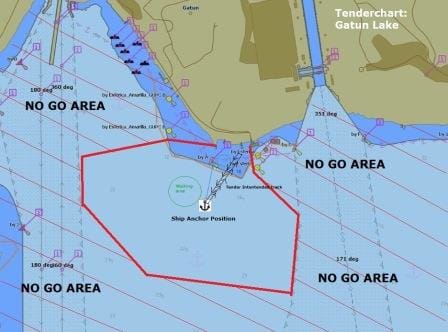
The tender chart for all drivers. It is a pity the ship has not been drawn in on scale, then it would been easier to understand that there is not much space.
The ship was sitting today or better said floating exactly in between the approaches to both locks. And we have to make sure it stays there. There is not much room at either side. Not only that, we also have to ensure that the tenders stay very close to “mother goose” as straying more than 300 feet away could cause them to enter the traffic lane for the Gatun Locks. Next to where the Zuiderdam is drifting is the exact location where the tugboats catch the cargo ships approaching the Gatun Locks. Thus a little tender getting in between would cause havoc in the routine. Plus the tenders are made out of aluminum and fiberglass and those tugboats are pure steel. So better stay well clear.
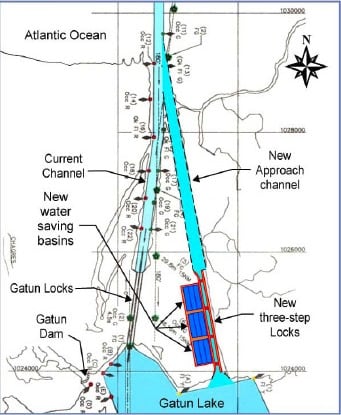
Our tender location in relation to the locks. The tenders go ashore exactly where the a of the word Gatun (Lake) is on the chartlet.
Tonight we will sail at 19.00 hrs. if everybody is on board that is coming back from the tour, and then it is a nights sailing to Puerto Limon in Costa Rica. Because that country lays a little bit further west than Panama, we will be going an hour back tonight. The only problem is we have to go forward again after we leave that port. We will be at the entrance at 06.00 hrs. and should be docked about 20 minutes later as Puerto Limon is an open bay port (hence the reason we had to cancel last cruise because of the incoming swell) and the ship just can charge in swing around and throw the lines ashore.
Weather for tomorrow: Partly Cloudy with a chance of showers. Warm with a temperature of 85oF / 209C and very little wind. And very little wind, means very little swell and thus we can make the port call.
A few guests thought today that I could predict the future as yesterday I explained to them when they could expect the ship to quiet down. I was right within about 30 minutes and that was considered amazing. It was of course not amazing at all, you just need a ruler. You lay that ruler on the chart in the general direction on the swell and move it towards the south side of Cuba. When the ships track comes north (or above) the line of the ruler after the ruler has hit the coast, then you have the probable moment when the swell will disappear. The swell is mostly a bit diffuse as well so you cannot pin it down to the minute but within the hour is possible. Nothing complicated but I will take the credit gladly.
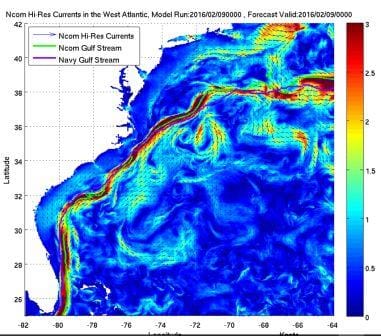
This is an example of a compressed Gulf Stream Chart from the NOAA. The deeper the red the stronger the current.
Early this morning we passed the west point of Cuba and then turned into the Straits of Florida and the Gulf Stream. To attain maximum advantage the navigator will first plot a course which is the shortest between Cabo San Antonio (Cuba’s West point) and the Miami area. That is where the Florida Coast & keys really curve, so the ship has to bend with the coast line. Then the course is adapted to where we think the axis of the Gulf Stream is so we can catch an extra push in the back of anything between 1 to 4 knots. The NOAA makes charts available on the internet with the average axis of the Gulf Stream but these charts are past observations and the Gulf Stream can move very quickly. Sometimes closer to Florida, sometimes closer to Cuba.
Thus we tend to aim and for the average axial line until we get there with the ship. Then we observe of how much more speed we are getting, compared to what we normally get from the engines. And then we try to get the best by steering a bit more one way or the other. If you have to maintain 18 knots and if you can find 4 knots free of charge then a bit of experimenting is worthwhile. Under water the Straits of Florida are in deep part quite a bit smaller then what it looks like on the surface. Water gets squeezed in a bit. So the closer we come to the South point of Florida, the more pronounced the current becomes. Especially if we are in the right location.
The Gulf Stream goes North East and later North following the curve of Florida and the Bahamas. But as water will flow back where it has been pushed away, there are also counter currents. Smaller, but still of interest. One runs along the Florida Keys to the South West, the other one north of the Cuban coast. The Florida Key one is the strongest as it can flow freely into the Gulf of Mexico. The one north of Cuba is less pronounced as it has to push (or try to push) its water around Cabo San Antonio. Still if you have to go that way then you might as well use it. Thus it made sense this morning when we saw a Celebrity Cruise Ship going towards the Caribbean sailing as close as possible to the Cuban coast. Taking advantage of this counter current or at least avoiding going against the edges of the Gulf Stream Looking at its speed it looked like she was nicely picking up a knot of so of this counter current.
This morning the good ship Zuiderdam had the benefit of 1.5 knots and by the evening it had increased to almost 3 knots. the 1.5 knots did not add much to the ships speed but it counteracted nicely to the strong East North Easterly wind that is blowing. For most of the day we had about 45 knots of it in relative speed. Take off 16 knots of the ship’s speed and that leaves around 30 knots of true – opposing – wind. Good enough to slow you down by a knot or so. Thus the Gulf Stream is nicely compensating. This wind is caused by a strong Weather front similar to the one which made us cancel Puerto Limon.
Tomorrow we are back in our home port Ft. Lauderdale but it is scheduled to be a quiet day as far as cruise ships are concerned. First ship in at 04.00 hrs will the small coastal passenger ship Pearl Mist followed by the Costa Deliziosa and the Coral Princess. The ms Zuiderdam will be the last in the line up, coming in at 06.15 to be docked at 06.50 at Pier 26. Ready for another turn over day at 07.00 hrs.
Weather for tomorrow: The wind is supposed to die down to about 12 knots and we are expecting partly sunny skies with temperatures just short of 80oF or 26oC.
It was not one of the best Panama Canal days in my life but it all worked out. Occasional rain, which it has to be otherwise The Canal Zone does not get its 200 inches of rain a year which it needs to operate the Canal; and very windy. However the wind was from the North and the First set of locks are almost north south as well. Only 8 degrees away from the true North. Thus the wind was only pushing or slowing the ship down, it was not causing much drift which otherwise would have hampered the lining up for the lock entrances.
This is a Panama Canal visit with a twist. You see the canal, by going through the first set of locks and then you have the option to take the local tours and catch the ship again in the evening. If you do not take a tour then you can see the ship sailing out of the lake again, back to open sea, and then sail to the dock at Manzanillo to collect the tour.
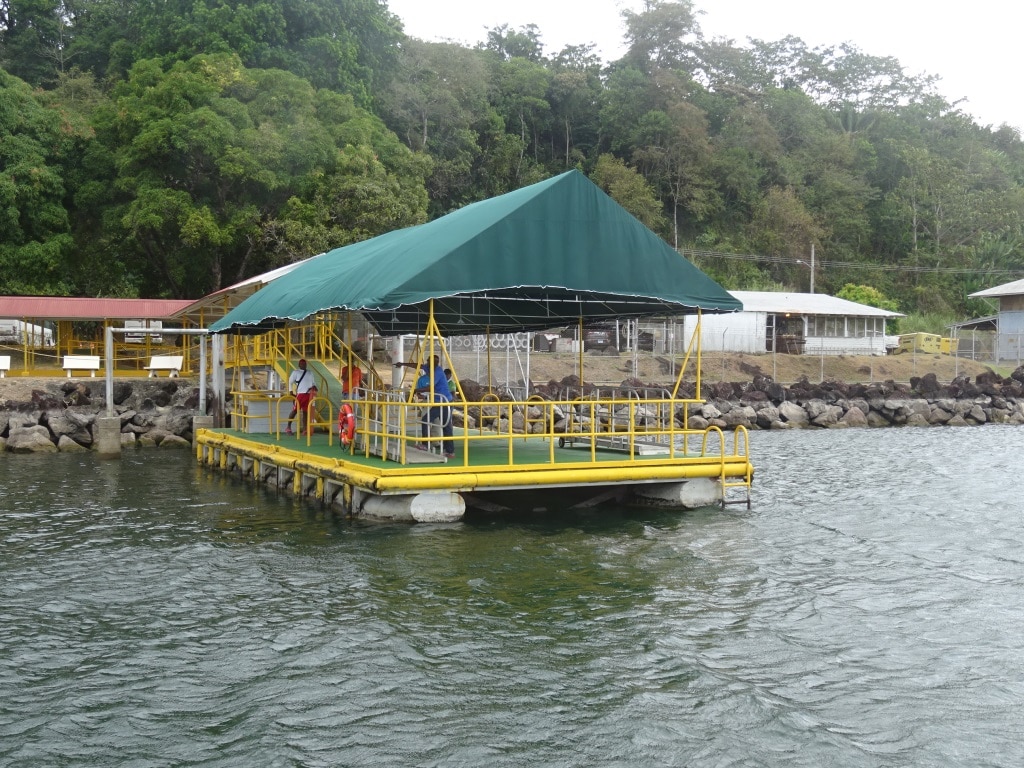
The tender dock we use to disembark the guests. Designed by a pilot and thus a delight to use by us. Safe mooring and safe loading and unloading. It floats as the level of the lake goes up and down with the rain fall.
This morning the whole happening started at 05.30 with the arrival at the pilot station. Then there is the clearing of the ship and then line up in the convoy. Although we are not going all the way through, the Panama Canal Authority still has to make sure that the locks are used efficiently and will lose as little water as possible. With the new locks in operation and thus more traffic, more water is used and focus on efficiency is now even more important than it was before. But by 09.00 we had made it through, had left the locks behind and the ship parked itself between the two lock sections in the anchorage area of Gatun Lake. All the tenders were lowered as we had to shuttle 1120 guests ashore, out of the 1970 on board, Thus it took two good hours before all the tours were on the way and the tenders had been retrieved. Then the ship was ready to turn around and go back.
This is the moment where everything goes out of the captains hands, as the ship can only go back if there is a gap in the convoy or no opposing traffic so the other side of the lock system can be used. Sometimes the ship has to wait one or two hours and then it docks just on time to collect the returning tour people again. Today we were lucky, there was a gap in the traffic and the ms Zuiderdam could slot in without having to wait. Good news as it gave the guests who remained on board the un-expected bonus of being able to go ashore and noise around in Colon 2000.
Sailing back, means going down the locks back to sea level, I personally find that more impressive than going up because it is easier to comprehend a downwards depth, than an upwards lift in measurement. Also there was now something new to see. They are building a bridge on the Atlantic side. First there was only the Bridge of the Americas near Panama City. Then they built the Centennial Bridge near the Continental divide (Culebra Cut) and while that was very nice, the Caribbean or Atlantic side could only cross over the bridge built into the Gatun locks or had use the ferries closer to Colon. Both created long waiting times if there was a lot of shipping traffic in and out of the locks. But now there is a new bridge being constructed which should be finished late 2017 or early 2018. I suppose it will depend on the amount of rain for how fast they can work.
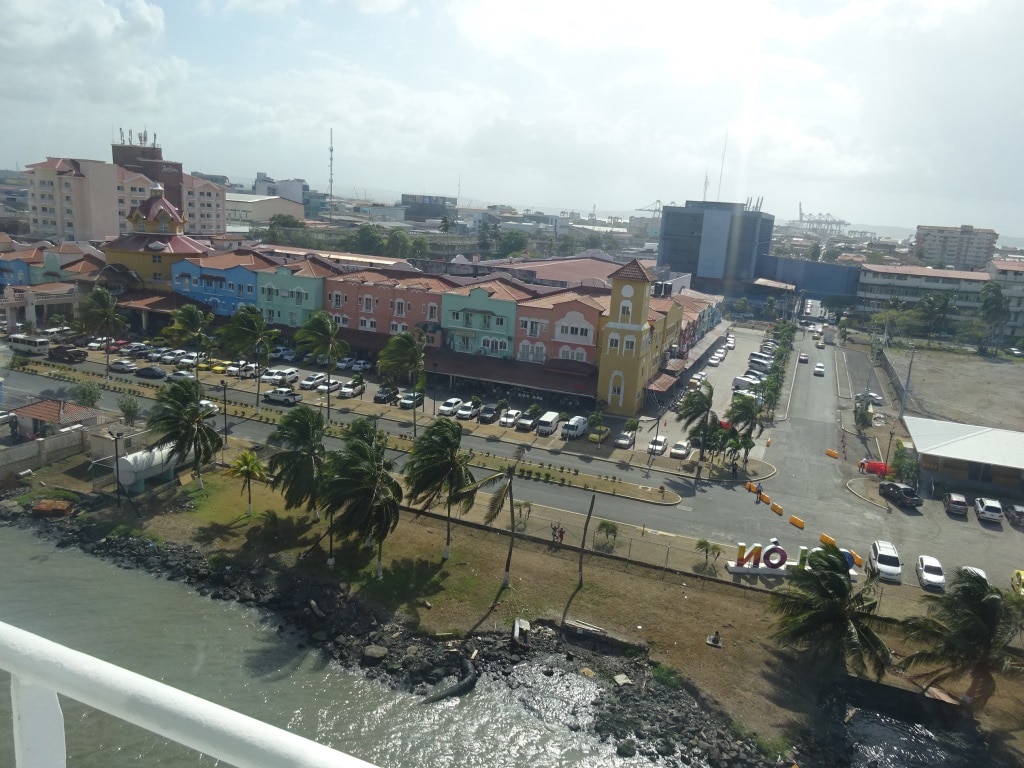
Colon 2000. I suppose the locals go here was well, but it seems to be focused on the cruise ships that stop here in ever increasing numbers.
Normally our ships docked at Cristobal but this season the ships have started using Colon 2000 full time, which is tucked away in the corner of the Manzanillo container port. To get there you have to sail out of the Panama Canal, make a sharp 180o turn in open sea, and then enter the port of Manzanillo. There they have two berths, dock 1, today in use by the Monarch of Pullmantur and Colon 2000 which is a sort of little terminal village with shops eateries and a Casino. We were docked by 15.00 hrs. which is a record so far and thus a bonus for the guests.
Tonight we will sail around 1900 hrs. and head for Puerto Limon in Costa Rica. Weather is expected to be the same; windy and a with certain chance of rain.
And thus we arrived in the early morning hours at the pilot station. I have at the moment the privilege of having a cabin right above the pilot boarding area and thus I was woken up by the pilot boat coming alongside at 05.26. That pilot boat definitely needed some engine work done to it. It made enough noise for a Boeing 747 and only enough speed to challenge a canoe. Still it managed to get the pilot on board and thus the ship could sail in without any delay. And we were alongside well before 07.00 hrs. This call is meant for tours and they all left at once after arrival. Guests had an early morning and for that the Culinary Department went to battle stations. The Lido Breakfast opened half an hour earlier than usual during a port day (06.00 hrs. instead of 06.30 hrs.), so did the Dining room, and all guests were advised that room service might have challenges sticking to the requested time. Nearly everybody wanted breakfast at 06.30 hrs.
All the cooks were lined up and even the Executive Chef was cooking to keep the momentum going. Dining room stewards were racing with their trolleys through the hall ways and every elevator was full with them as well. But they managed and everybody who wanted to stay and eat in the cabin got their breakfast delivered. I had to rescue a poor steward from a sleepy husband who told a dining room steward rather unfriendly that he had not ordered any breakfast. But the card was correct so I asked if he could double check with his wife. I was ready to take the flack for this instead of the steward but then it turned out that indeed his wife had ordered and then said to her husband “and I told you so, but you never listen”. (Where have it heard that myself before ???) So the steward was let in, had the lady check the order – all correct-, and then came out again and closed the door. Then we both walked away, while sounds were starting to come out of the cabin indicating a domestic dispute about Room Service.
While in port I observed something of interest. Tugboats. Owned by three different company’s and they all looked the same. What has happened in the tugboat – building – industry in the last 10 to 15 years is quite revolutionary. In the past every tugboat company had a local builder who built a tugboat to the owner’s specification and then the owner had to wait for it to be completed. Then a ship yard owned by Damen of the Netherlands calculated how many tugboats there are in the world and started to build them in advance in several classes (boat and engine size) and then laid them up half finished. Then if somebody wanted to buy a new tugboat, he could choose a standard model that in a very short time would be finished to the required personal specifications. Advantage is that serial building gives lower costs and the delivery time is very short as only electronics and bespoke interior do not take much time to install. As a result we see these standard tugs appearing everywhere in the world. (We will see them tomorrow as well in the Panama Canal). Only in the USA they are not frequent as domestic service requires legally American keel built ships.
So today, the port tugs boats were Damen built, the private harbor tugboats were Damen built and the dredger service tugboats (from a Dutch company called BosKalis) were also Damen built. The latter company is busy with helping to create a new port area.
Final observation of the day, very dramatic. I blogged some time ago that in the middle of the inner harbor there was a statue of the Virgin Carmen, patron of the sailors. Not any longer, the statue got damaged severely by a lighting hit. Whether Carmen was naughty or Zeus got jealous but one flash and everything was broken. At the moment only the pedestal survives. We have to keep an eye out to see if and when the statue will return.
By 14.00 hrs. we were back in the open ocean and going pedal to the metal to the Panama Canal, where we do a dip in / dip out of the first locks, send ashore the tour while in the Gatun Lake and then later dock in Colon (really Cristobal) for an evening stay and to collect the tour again.
This is our tentative Panama Canal schedule:………………. But as usual: subject to extremely much change.
Pilot on board 05:30hrs
Gatun Locks (East Lane) SB Passage
Arriving 07:15hrs
Departing 09:30hrs
Anchoring 09:55hrs
Reassuming NB Passage11:00hrs
Gatun Locks (West Lane) NB Passage
Arriving 11:15hrs
Departing 13:40hrs
Docking 15:30hrs
Weather: supposed to be windy and overcast with rain showers. I hope the weather gurus will be wrong.
© 2025 – Captain Albert's Website and Blog –
Theme by Anders Noren — Up ↑
